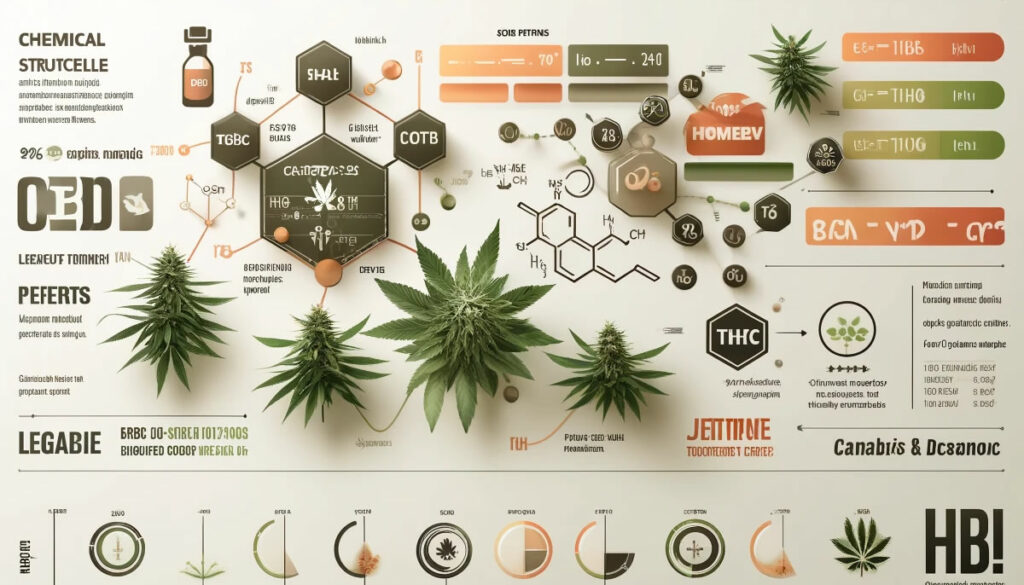As the popularity of cannabis-derived products continues to soar, two cannabinoids have emerged as the primary focus of attention: cannabidiol (CBD) and delta-9-tetrahydrocannabinol (THC). While these compounds share a similar chemical structure, they interact with the human body in distinct ways, leading to different effects and potential therapeutic applications. In this comprehensive comparison, we’ll explore the key differences and similarities between CBD and THC, shedding light on their origins, benefits, side effects, and legal status.
Chemical Structure: A Subtle Difference
CBD and THC are two of the many cannabinoids found in the cannabis plant, alongside more than 100 other identified compounds (1). Despite their similar chemical composition, with both containing 21 carbon atoms, 30 hydrogen atoms, and 2 oxygen atoms, a slight variation in the arrangement of these atoms accounts for the distinct properties of each cannabinoid (2).
Origins: Hemp vs. Other Cannabis Strains
Both CBD and THC are naturally present in cannabis plants, but the levels of each cannabinoid vary depending on the specific strain. CBD is predominantly derived from hemp, a variety of the Cannabis sativa plant that contains less than 0.3% THC, as defined by the 2018 Farm Bill (3). In contrast, other cannabis strains typically contain higher levels of THC and lower levels of CBD. Over the years, the average potency of cannabis plants has increased, with THC levels rising from roughly 4% in 1995 to 12% in 2014, while CBD levels have decreased from 0.28% to less than 0.15% during the same period (4).
Potential Benefits: Treating a Range of Conditions
CBD and THC have shown promise in treating various medical conditions, although their specific applications may differ. CBD is commonly used to help alleviate symptoms associated with inflammatory bowel disease, seizures, depression, inflammation, psychosis, and migraines (5). On the other hand, THC has potential uses in treating glaucoma, muscle spasticity, low appetite, and insomnia (6). Both cannabinoids may be effective in managing pain, anxiety, and nausea (7).
Side Effects: Safety and Considerations
According to the World Health Organization (WHO), CBD is generally safe and does not appear to have abuse potential or cause harm (8). The Food and Drug Administration (FDA) suggests that potential side effects of CBD may be the result of interactions with other medications and could impact liver function and male fertility (9).
THC, while not fatal when taken correctly, may cause temporary side effects such as dry mouth, red eyes, slower response times, memory loss, coordination issues, and increased heart rate (10). Teenagers who consume THC may be at risk of adverse psychiatric effects, particularly if they have a genetic predisposition or family history of schizophrenia (11).
Forms and Administration Methods
CBD and THC can be consumed in various forms, allowing individuals to choose the method that best suits their needs and preferences. CBD is available as oils, gummies, capsules, and tinctures, while THC can be found in smokable products, oils, tinctures, and edibles like brownies (12).
Legal Status: Navigating the Complexities
The legality of CBD and THC varies by state and is subject to change as laws evolve. While several states have approved the use of medical and recreational cannabis, it remains illegal under federal law (13). The 2018 Farm Bill legalized hemp-derived CBD products containing less than 0.3% THC, but CBD products with higher THC levels are still considered marijuana and remain federally illegal, despite being legal in some states (14). It is crucial for individuals to research and stay updated on the laws in their state before acquiring or using cannabis products.
The High: CBD vs. THC
One of the most significant differences between CBD and THC lies in their ability to produce the “high” commonly associated with cannabis use. THC binds to the main cannabinoid receptors in the brain, mimicking the effects of anandamide, a naturally occurring endocannabinoid (15). This interaction leads to the psychoactive effects or “high” experienced by THC consumers.
In contrast, CBD does not create the same high sensation, as it interacts differently with cannabinoid receptors. While experts are not entirely certain how CBD interacts with these receptors, it is believed to bind differently than THC or potentially bind to other receptors that have not yet been discovered (16).
Conclusion
As the world of cannabis-derived products continues to evolve, understanding the differences and similarities between CBD and THC is essential for making informed decisions about their use. While both cannabinoids have shown potential in treating various medical conditions, their distinct properties, side effects, and legal status set them apart. As always, it is crucial to consult with a healthcare professional before incorporating CBD or THC into a treatment plan and to stay informed about the latest research and legal developments surrounding these fascinating compounds.
References
1. Aizpurua-Olaizola, O., Soydaner, U., Öztürk, E., Schibano, D., Simsir, Y., Navarro, P., Etxebarria, N., & Usobiaga, A. (2016). Evolution of the Cannabinoid and Terpene Content during the Growth of Cannabis sativa Plants from Different Chemotypes. Journal of Natural Products, 79(2), 324-331. https://doi.org/10.1021/acs.jnatprod.5b00949
2. Hanuš, L. O., Meyer, S. M., Muñoz, E., Taglialatela-Scafati, O., & Appendino, G. (2016). Phytocannabinoids: a unified critical inventory. Natural Product Reports, 33(12), 1357-1392. https://doi.org/10.1039/c6np00074f
3. U.S. Food and Drug Administration. (2021, January 22). FDA Regulation of Cannabis and Cannabis-Derived Products: Q&A. https://www.fda.gov/news-events/public-health-focus/fda-regulation-cannabis-and-cannabis-derived-products-including-cannabidiol-cbd#legaltosell
4. ElSohly, M. A., Mehmedic, Z., Foster, S., Gon, C., Chandra, S., & Church, J. C. (2016). Changes in Cannabis Potency Over the Last 2 Decades (1995-2014): Analysis of Current Data in the United States. Biological Psychiatry, 79(7), 613-619. https://doi.org/10.1016/j.biopsych.2016.01.004
5. Corroon, J., & Phillips, J. A. (2018). A Cross-Sectional Study of Cannabidiol Users. Cannabis and Cannabinoid Research, 3(1), 152-161. https://doi.org/10.1089/can.2018.0006
6. Whiting, P. F., Wolff, R. F., Deshpande, S., Di Nisio, M., Duffy, S., Hernandez, A. V., Keurentjes, J. C., Lang, S., Misso, K., Ryder, S., Schmidlkofer, S., Westwood, M., & Kleijnen, J. (2015). Cannabinoids for Medical Use: A Systematic Review and Meta-analysis. JAMA, 313(24), 2456-2473. https://doi.org/10.1001/jama.2015.6358
7. Russo, E. B. (2008). Cannabinoids in the management of difficult to treat pain. Therapeutics and Clinical Risk Management, 4(1), 245-259. https://www.ncbi.nlm.nih.gov/pmc/articles/PMC2503660/
8. World Health Organization. (2018, June). Cannabidiol (CBD) Critical Review Report. https://www.who.int/medicines/access/controlled-substances/CannabidiolCriticalReview.pdf
9. U.S. Food and Drug Administration. (2020, March 5). What You Need to Know (And What We’re Working to Find Out) About Products Containing Cannabis or Cannabis-derived Compounds, Including CBD. https://www.fda.gov/consumers/consumer-updates/what-you-need-know-and-what-were-working-find-out-about-products-containing-cannabis-or-cannabis
10. Volkow, N. D., Baler, R. D., Compton, W. M., & Weiss, S. R. B. (2014). Adverse Health Effects of Marijuana Use. New England Journal of Medicine, 370(23), 2219-2227. https://doi.org/10.1056/nejmra1402309
11. Malone, D. T., Hill, M. N., & Rubino, T. (2010). Adolescent cannabis use and psychosis: epidemiology and neurodevelopmental models. British Journal of Pharmacology, 160(3), 511-522. https://doi.org/10.1111/j.1476-5381.2010.00721.x
12. MacCallum, C. A., & Russo, E. B. (2018). Practical considerations in medical cannabis administration and dosing. European Journal of Internal Medicine, 49, 12-19. https://doi.org/10.1016/j.ejim.2018.01.004
13. National Conference of State Legislatures. (2021, April 8). State Medical Marijuana Laws. https://www.ncsl.org/research/health/state-medical-marijuana-laws.aspx
14. U.S. Food and Drug Administration. (2020, October 1). FDA and Cannabis: Research and Drug Approval Process. https://www.fda.gov/news-events/public-health-focus/fda-and-cannabis-research-and-drug-approval-process
15. Lu, H. C., & Mackie, K. (2016). An Introduction to the Endogenous Cannabinoid System. Biological Psychiatry, 79(7), 516-525. https://doi.org/10.1016/j.biopsych.2015.07.028
16. Pertwee, R. G. (2008). The diverse CB1 and CB2 receptor pharmacology of three plant cannabinoids: Δ9-tetrahydrocannabinol, cannabidiol and Δ9-tetrahydrocannabivarin. British Journal of Pharmacology, 153(2), 199-215. https://doi.org/10.1038/sj.bjp.0707442
- Kentucky Vape & Tobacco Retailer License Deadline Jan 1 - January 3, 2026
- Washington State Nicotine Tax to Double Vape Prices - January 3, 2026
- Pennsylvania Mandates Vape Product Registry for Shops - December 24, 2025


